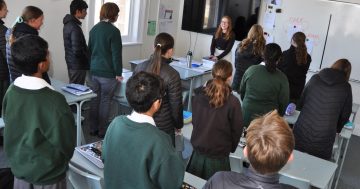
The Raising the Grade report says one in three 15-year-old students in the ACT isn’t meeting the reading benchmark. Photo: Thomas Lucraft.
Every day, Scarlett Gaffey from Majura Park Speech Pathology is kept busy with “instructional casualties” of the ACT public education system.
“I see children coming into my practice who have been taught to guess words, which is a strategy used by poor readers, not by strong readers, and it’s actually harmful for some kids who never drop the habit,” the local parent and speech pathologist says.
“Kids are often instructional casualties where there is no real reason they can’t learn to read except they have not been taught well enough. The research and Australian curriculum say schools should be teaching kids to sound out words yet, in Canberra, that is often not the case.”
According to a new report, one in three 15-year-old students in the ACT isn’t meeting the reading benchmark – it’s enough to fill Bruce Stadium.
The Raising the Grade report by Equity Economics (and funded by the Snow Foundation) says the percentage of ACT students below the Australian proficient standard for reading in the Programme for International Student Assessment (PISA) is growing, and the ACT Government must act fast to prevent future generations from struggling to make it into higher education or a well-paying job.
“The ACT’s performance in reading literacy has been in long-term decline, equivalent to around half a year of lost schooling,” the report reads.
“The percentage of low performers in the ACT has increased from 8 per cent in 2000 to 13 per cent in 2018.”
The results from the latest 2022 PISA are yet to be released, but recent data from the National Assessment Program – Literacy and Numeracy (NAPLAN) doesn’t suggest the trajectory will have changed.
Almost one in five Year 9 students in the ACT are at or below NAPLAN’s National Minimum Standards for reading, which basically means they are operating at a Year 6 level.
Report co-author Jessica Del Rio describes the ACT public education system as “basically a lottery”, with no certainty a child will be reading proficiently by graduation.
“The data is showing that kids in Canberra schools aren’t reaching their potential. There are a lot of very advantaged kids who aren’t reaching their potential, and there’s an even higher proportion of disadvantaged kids who aren’t reaching their potential,” she says.
“Literacy matters. It contributes to whether a person will get a job, earn a good income, not to mention their physical and mental health. Children who struggle with reading are more likely to become tomorrow’s lowest-income, least-skilled citizens. They’re more likely to rely on government support and increase costs to our health system. It’s not only bad for them, it’s bad for the economy and it’s bad for Canberra.”
Ms Del Rio says the teachers are ill-equipped to deal with the problem too.
“Unclear guidance leaves teachers to figure out for themselves what to teach, what order to teach it in, how to teach it and to what level,” she says.
“Teachers aren’t learning these skills at uni. We spoke to teachers, and they said they had this feeling that something was off, that there were kids who were getting left behind, but they didn’t know what to do.”

Catholic Education Archdiocese of Canberra & Goulburn Ross Fox says the ‘Catalyst’ curriculum resulted from “a lot of investigation, discussion, research and consultations”. Photo: Catholic Education.
The report outlines several “evidence-based strategies” the ACT Government could implement to improve literacy outcomes across the board, at a cost of $11 million but at a benefit of “$200 million in increased earnings for our kids”.
These strategies include the more faithful adoption of the Australian curriculum – which requires children to sound out words phonetically – as well as better training for teachers through collaboration with universities, more one-on-one support for struggling students, and the establishment of a purpose-built reading clinic designed to “provide targeted intervention for students requiring additional support”.
It also points to the relative success enjoyed by the 56 Catholic schools across the ACT and NSW ever since Catholic Education Canberra and Goulburn (CECG) introduced a new teaching approach three years ago.
In 2019, 42 per cent of Catholic schools and 54 per cent of government schools were underperforming. By 2022, however, the tables had turned and only 4 per cent of Catholic schools underperformed compared to 60 per cent of government schools.
CECG director Ross Fox says the ‘Catalyst’ curriculum was the result of “a lot of investigation, discussion, research and consultations”.
“We have two aims – to ensure every student is a competent reader and to make high-impact teaching visible in every classroom,” he says.
More time is needed to truly work out what effect the change is having on outcomes for students, but hopes are high.
“We are seeing significant improvements in schools and classrooms and positive feedback from parents that we are on the right track and making good progress.”
The ACT Education Directorate is currently “reviewing the details” in the Equity Economics report.
“The ACT public school system provides a systematic, evidence-based approach to early literacy instruction … based on the research of Professor Nell K Duke,” a government spokesperson said.
“The ACT is the highest performing Australian jurisdiction in reading literacy, as measured through international assessments for 15-year-olds through the Programme for International Student Assessment (PISA) 2018, as well as for Year 4 students in the Progress in International Reading Literacy Study (PIRLS) 2021.”
The directorate said all schools teach to the Australian curriculum and are being supported to deliver the latest version from next year.





















